
Ranga Ebonite Bamboo a pen like no other
The Bamboo Calligraphy tool, it is widely believed, is as old as time. The Arabic calligraphers were among the first to use them widely and it wasn’t long before they became almost de rigueur among all the scribes in the Islamic world. In Japan, Susutake – smoked bamboo, obtained from the roof thatches – were also known to have been used by the masters. These bamboo shoots, aged by being continuously exposed to the smoke emanating from the hearth below, was known to have special qualities that made it a material of choice for the ace calligraphers of the day. In China too, the use of bamboo for fashioning writing instruments date back to times immemorial.
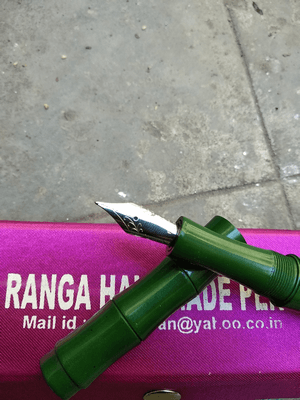
The Bamboo ebonite fountain pen – one that resembles the wood-like stems of bamboo plants with their pronounced nodes – is also one that can trace its origin back to the days when the hollow stems of the plant were used to hold the ink with the nib inserted on one of the ends, used for the writing. When or where the bamboo was replaced with ebonite, or which master had actually turned the first pen in which country, is now something that is lost in the mists of time. What is important, however, is the fact that the Bamboo pen continues to be one that is highly sought after by fountain pen aficionados from around the world.
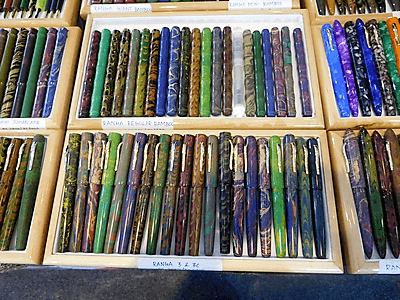
Who turned the first ebonite Bamboo pen in India, why they are called “Japanese style” pens, when the art was perfected by Indian craftsmen, did it evolve out of our own mastery with bamboo craftsmanship, or was the technique an import from the far east? These are all matters of conjecture and are hotly debated. But two things are generally accepted – while many materials have been, and continue to be used, to turn the Bamboo pens in India, it is the hand-turned ebonite pens that are held sacred and among the makers, it is the Thiruvallur (in Tamil Nadu) based House of Ranga, who are acknowledged as the finest exponents of the art.
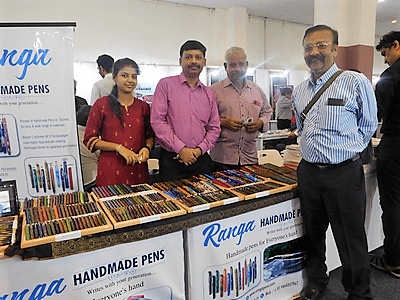
Imagine my exultation then, when I came across the Master himself – MS Pandurangan along with his son and daughter – representing two generations of Indian pen making as it were, at the 1st India Pen Show in Mumbai. As I stood, mesmerised by the spread of his creation before him, it was the cluster of Bamboo Pens that were cajoling me for a soft caress, urging, that their nibs be uncapped and put on paper.
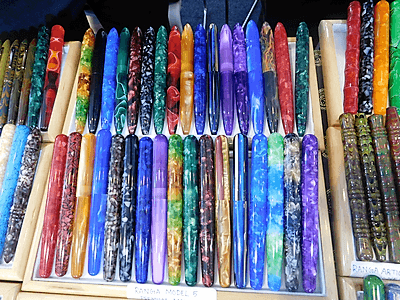
The pen, in its cap-less avatar, has a feeling that is unique. The nodes are crafted to heighten the grip as it slides effortlessly between one’s fingers, the thumb completing the hold. The barrel diameter of 16 mm (section diameter is 11 mm) makes it ideal for prolonged use. Fitted with a Schmidt K5 converter, the pen holds a good amount of ink and the imported German nib naturally leaves no room for complaint. Suffice to say, from filling in the ink, to the actual writing, was like one fell swoop and what was “love at first sight”, has quickly turned into “love at first write” now.
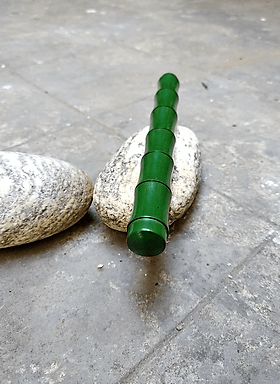
MS Pandurangan had started Ranga Pens way back in the 1970’s, which means that he has been hand turning pens for more than five decades now. Coming from the so-called “conservative” southern parts of the country, the master and the company he heads, are quite literally, footed firmly in traditions. He is known to use the exact same techniques that he had learnt in his teens, which explains not only the choice of materials and the near obsessive stress on perfection, but also the superb finish that no amount of mass-produced, even imported implements can compete with. When one spends more than five decades of his life perfecting an art, it is but natural that the perfection will reach the apogee – even the global accolades and the awe-struck admiration of the fountain pen community matter little to the dedication and the sheer love with which the master turns his pens.
It is therefore, enough by way of description to say that Ranga Pens terms the Bamboo pen as its “flagship” model. It is no coincidence then, that like the bamboo plant, Ranga’s Bamboo too flowers once in fifty years !
I rest my case.
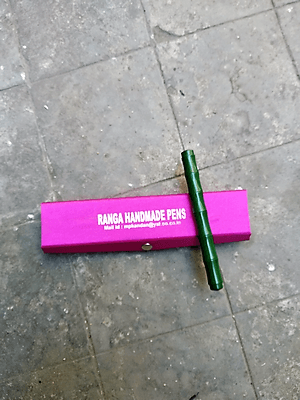
Note:
Fountain pen lovers have the options to select from an unlimited range of colours (premium ebonites are known for their vibrant hues) and a variety of Nib choices. What is more, all the colours are available in Mirror Finish and Brushed (Rough / Matt) Finish. Don’t go by the pictures – the mottled patterns on the pens will vary from one to the other, which adds another mystic facet to these pens. These pens can also be used as eyedroppers and are known to carry an almost inexhaustible supply of ink in their bellies, without being too unwieldy in the hand.

For More information: www.rangapens.com

I was curious about Ranga pens when i first saw the pictures of them with you at the pen show. Thank you for this article.
Made made out of bamboo is unique and classic. Its also eco friendly i think. The designs are very beautiful and colorful.
Indian handcrafted pens always fascinated me. Nice to see ranga pens are putting all the efforts to bring this craftsmanship to the market.
Chawm… thank you for your lucid description of Ranga handmade pens. It is heartening to see them last through the most difficult three decades of digital onslaught. Such traditional fountain pen making needs encouragement and patronage having endured the toughest times, they should now step up their game in the modern times to reach out to more nature loving fountain pen enthusiasts and continue to enthralled them with their innovations!
Dear Mr. K.C. Janardhan Sir,
We are very happy to read your comments and opinion. Thanks for your well wishing thoughts.
You are correct. It is very tough to survive 20+ years of Fountain Pen recession . We did it.
We will make our best to take our art to next level with support from all of you
Our Chawm Dada took this initiative , which is great help for all fountain pen stake holder’s
Regards,
Kandan.M.P
Ranga Pen Company
Nice article about ebonite fountain pen. fountain pen images are beautiful.